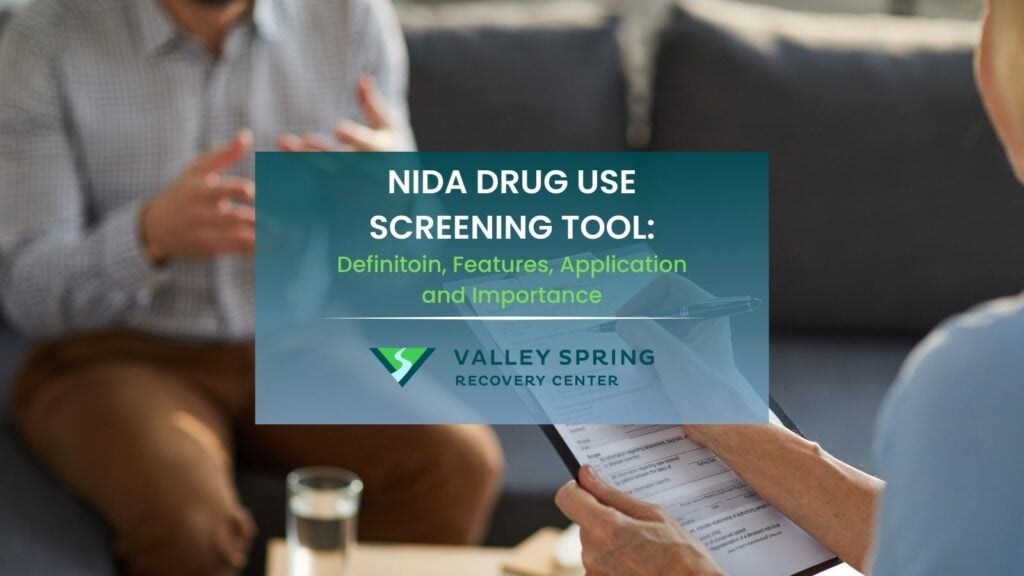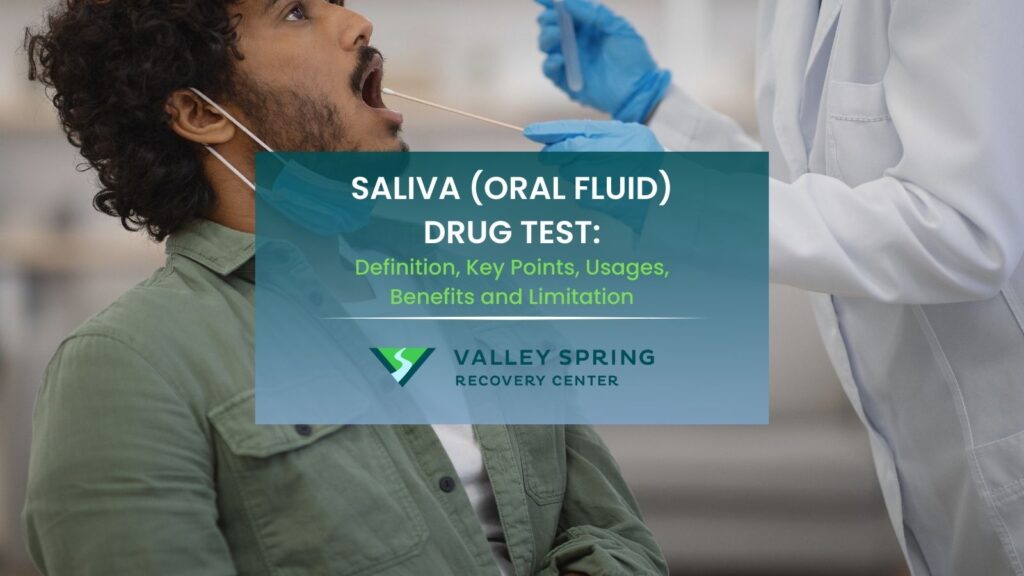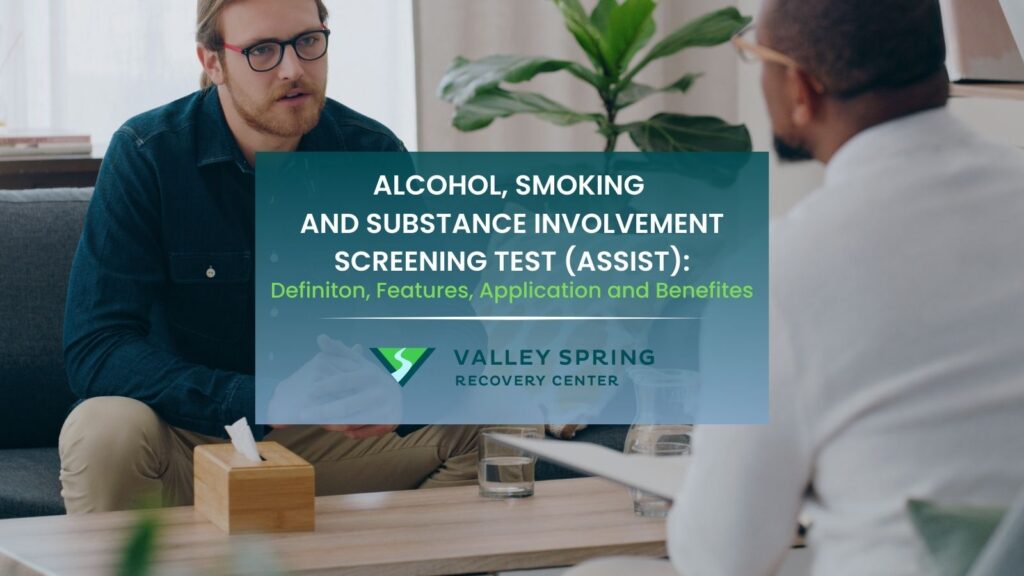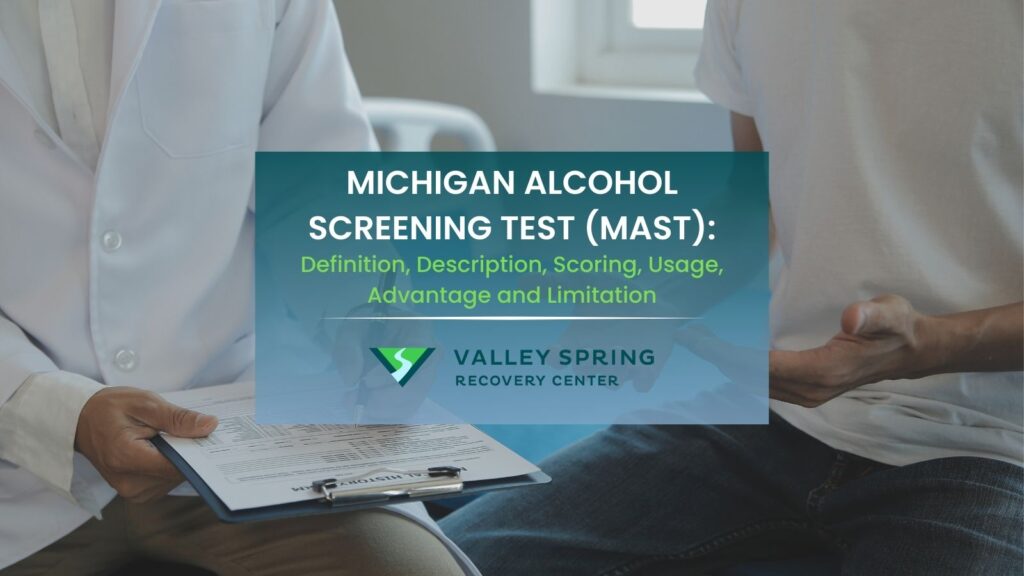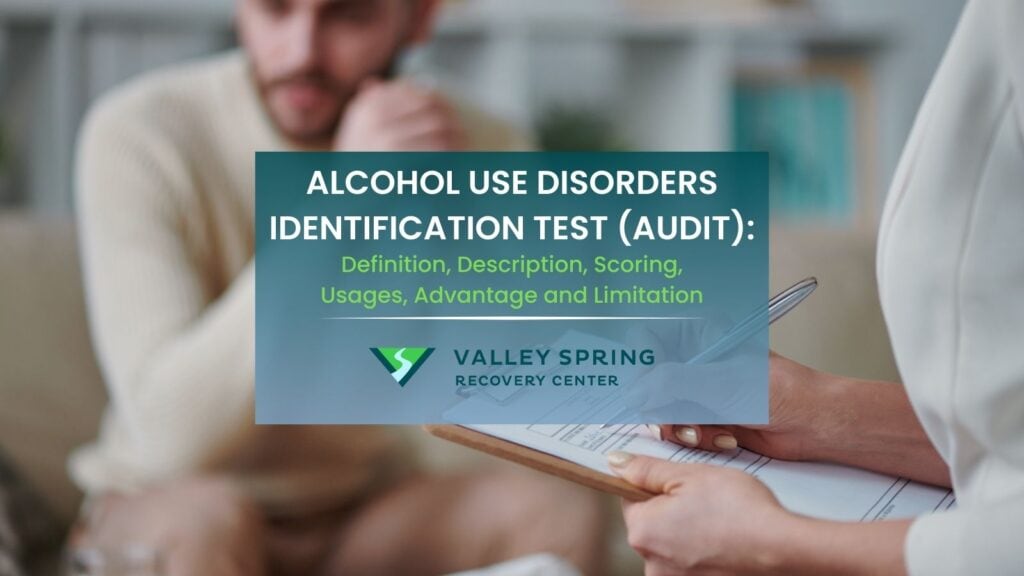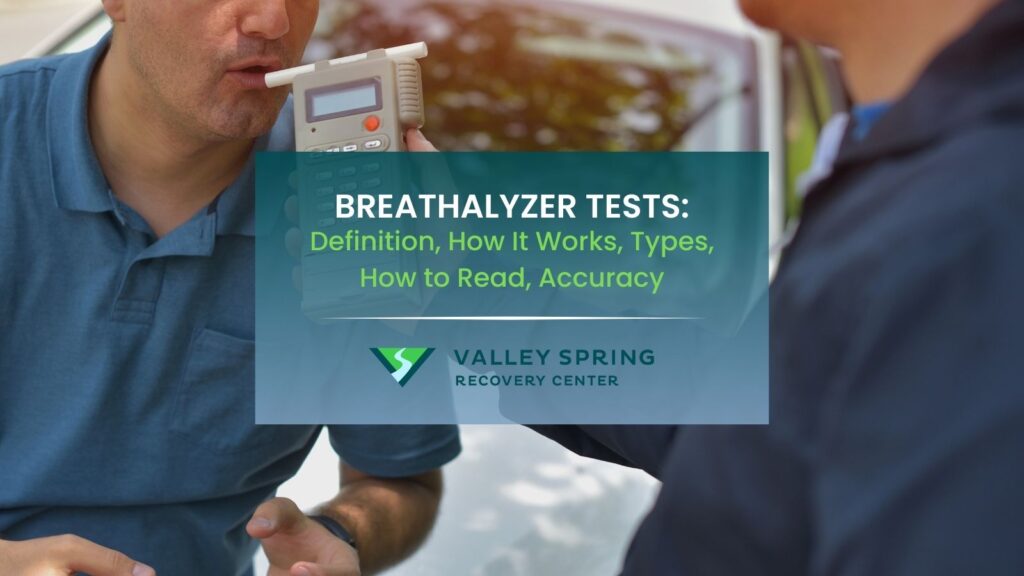The NIDA Drug Use Screening Tool is a valuable resource in the field of substance use assessment. This tool helps healthcare professionals and researchers identify individuals who may be at risk for drug-related problems.
The NIDA Drug Use Screening Tool features a standardized questionnaire designed to assess drug use patterns, identify potential problems, and guide interventions.
The NIDA Drug Use Screening Tool is applied in healthcare settings and research studies to identify individuals at risk for substance use disorders, guide interventions, and inform public health policies.
The NIDA Drug Use Screening Tool provides early identification of drug-related problems, a standardized approach to assessing drug use, and targeted interventions, resulting in improved outcomes and tailored treatment plans.
What is the NIDA Drug Use Screening Tool?
The NIDA Drug Use Screening Tool, developed by the National Institute on Drug Abuse (NIDA), is a tool designed to help identify individuals who may be engaging in drug use or experiencing drug-related problems. It is a simple questionnaire that can be used by healthcare professionals or researchers to assess an individual’s drug use patterns and determine if further evaluation or intervention is necessary.
The screening tool typically consists of a series of questions that ask about various aspects of drug use, such as the types of drugs used, the frequency of use, and any problems or consequences associated with drug use. The questions are straightforward and easy to understand, making it accessible for individuals who may not have a medical or scientific background.
By using the NIDA Drug Use Screening Tool, healthcare professionals can quickly gather information about an individual’s drug use habits and identify potential risks or concerns. Based on the responses provided, further assessment or appropriate interventions can be recommended if necessary. The tool serves as an initial step in the process of evaluating drug use and assisting individuals in receiving the support they may need.
It’s important to note that the NIDA Drug Use Screening Tool is not a diagnostic tool but rather a screening tool to identify potential drug-related issues. If someone screens positive for drug use or experiences drug-related problems, additional assessments or evaluations are required for a more comprehensive understanding of their situation.
What Does the NIDA Drug Use Screening Tool Feature?
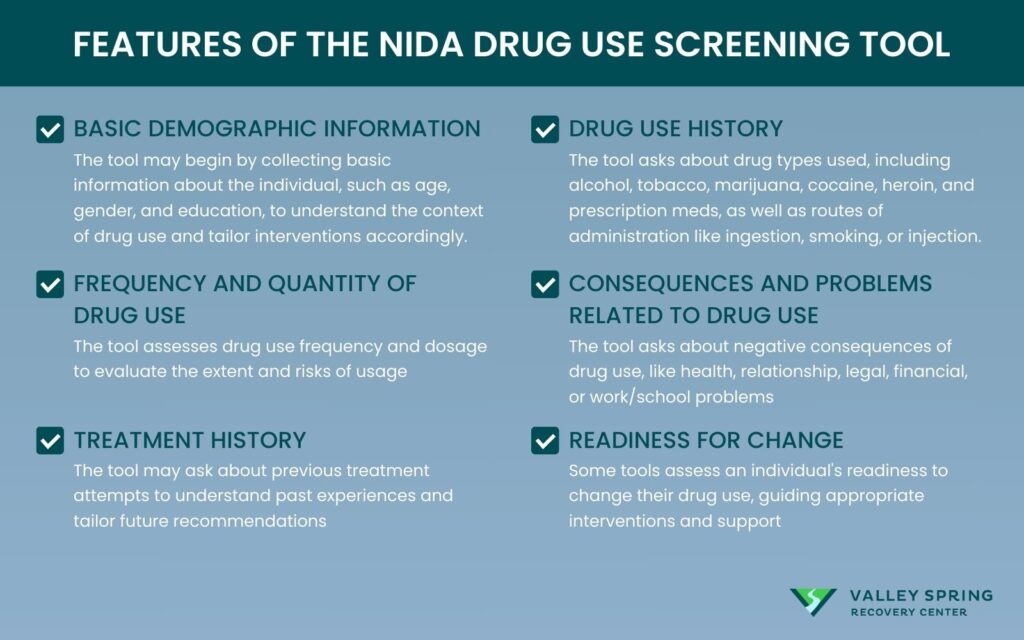
The NIDA Drug Use Screening Tool typically consists of a set of questions that aim to gather information about an individual’s drug use patterns and potential drug-related problems. While the specific questions may vary depending on the version of the tool being used, here are some common features and areas covered by the screening tool:
1. Basic demographic information
The tool may start by collecting general information about the individual, such as their age, gender, and educational background. This information helps in understanding the context of the drug use and tailoring interventions if needed.
2. Drug use history
The screening tool will ask questions about the types of drugs the individual has used, including legal substances like alcohol and tobacco, as well as illicit drugs such as marijuana, cocaine, heroin, or prescription medications. It may also inquire about the routes of drug administration, such as oral ingestion, smoking, or injection.
3. Frequency and quantity of drug use
The tool will explore how often the individual uses drugs and the approximate amount or dosage consumed during each episode. This information helps in assessing the extent of drug use and identifying potential risks associated with heavy or frequent use.
4. Consequences and problems related to drug use
The screening tool will ask about any negative consequences or problems experienced as a result of drug use. This can include physical or mental health issues, relationship problems, legal troubles, financial difficulties, or difficulties at work or school.
5. Treatment history
The tool may include questions about any previous attempts to seek treatment for drug-related issues. This information helps in understanding the individual’s past experiences with interventions and tailoring future treatment recommendations.
6. Readiness for change
Some screening tools include questions to assess an individual’s readiness or motivation to make changes in their drug use behavior. This information can guide the healthcare professional in determining appropriate interventions and support.
It’s important to note that the specific questions and format of the NIDA Drug Use Screening Tool may vary depending on the purpose and setting in which it is used. The tool is designed to provide a standardized approach to gathering information about drug use and identifying potential areas of concern.
How is the NIDA Drug Use Screening Tool Used (Application)?
The NIDA Drug Use Screening Tool can be used in various healthcare settings, research studies, or community programs to assess an individual’s drug use patterns and identify potential drug-related problems.
1. Administration
The tool is usually administered by a healthcare professional, such as a doctor, nurse, counselor, or researcher. It can be conducted in person, through a face-to-face interview, or self-administered using a written questionnaire or computer-based format.
2. Confidentiality and privacy
It is important to ensure the privacy and confidentiality of the individual’s responses. This helps to create a safe and non-judgmental environment that encourages honest and accurate reporting.
3. Questionnaire completion
The individual completes the screening tool by answering the questions provided. The questions may cover various aspects of drug use, including the types of drugs used, frequency of use, consequences experienced, and treatment history. The individual should answer the questions to the best of their knowledge and abilities.
4. Scoring and interpretation
Once the screening tool is completed, the healthcare professional or researcher scores the questionnaire. Scoring methods may vary depending on the specific tool being used. The scoring helps to identify potential areas of concern and determine the level of risk associated with the individual’s drug use.
5. Further assessment or referral
Based on the screening results, the healthcare professional or researcher may determine if further assessment or intervention is necessary. A positive screening result may indicate a need for additional evaluation, such as a comprehensive drug use assessment or a referral to a specialized addiction treatment provider. The screening tool helps to identify individuals who may benefit from further support or intervention.
6. Intervention and treatment planning
If drug-related issues are identified, the screening tool can guide the development of appropriate interventions and treatment plans. It can help healthcare professionals tailor interventions to the individual’s specific needs, such as providing education, counseling, or connecting them with appropriate resources and support services.
The NIDA Drug Use Screening Tool serves as an initial step in the process of identifying and addressing drug-related problems. It helps to streamline the assessment process, identify those at risk, and guide appropriate interventions to promote better health outcomes.
What is the Importance of the NIDA Drug Use Screening Tool?
The NIDA drug use and screening tool he tool is important for comprehensive screening and assessment, early and easy administration, integration into practice. According to research by the US Preventive Services Task Force, Krist AH, et al. Screening for Unhealthy Drug Use: US Preventive Services Task Force Recommendation Statement. (JAMA. 2020), the USPSTF recommends screening adults aged 18 years or older for unhealthy drug use by asking questions about their drug use behaviors. This recommendation is given a Grade B, indicating that the USPSTF believes there is high certainty that the net benefit is moderate or there is moderate certainty that the net benefit is moderate to substantial. Here are some of the importance of the NIDA drug use screening tool.
1. Early identification
The screening tool helps identify individuals who may be engaging in drug use or experiencing drug-related problems at an early stage. Early identification allows for timely intervention and support, which can help prevent the escalation of drug use and associated consequences.
2. Standardized approach
The NIDA Drug Use Screening Tool provides a standardized approach to gathering information about drug use. By using a consistent set of questions, healthcare professionals and researchers can obtain reliable and comparable data across different individuals and settings. This standardization enhances the accuracy and validity of the screening process.
3. Efficiency and simplicity
The screening tool is designed to be efficient and user-friendly. It typically consists of a concise set of questions that can be completed relatively quickly. This makes it practical for use in busy healthcare settings or research studies where time and resources may be limited.
4. Targeted interventions
By identifying individuals who may be at risk for drug-related problems, the screening tool helps tailor interventions and treatment plans to meet their specific needs. It assists healthcare professionals in providing appropriate education, counseling, and referrals to specialized services, thus improving the effectiveness of interventions.
5. Research and data collection
The screening tool facilitates the collection of data on drug use patterns and trends, which is valuable for research purposes. By systematically gathering information on drug use, researchers can analyze and monitor changes in drug use behaviors, evaluate the effectiveness of interventions, and inform public health policies.
6. Destigmatization and patient-centered care
The use of a screening tool helps to normalize discussions about drug use and reduce stigma associated with substance use disorders. It allows healthcare professionals to approach the topic in a non-judgmental and supportive manner, promoting open communication and facilitating patient-centered care.
What are the Different Types of NIDA Drug Use Screening Tools?
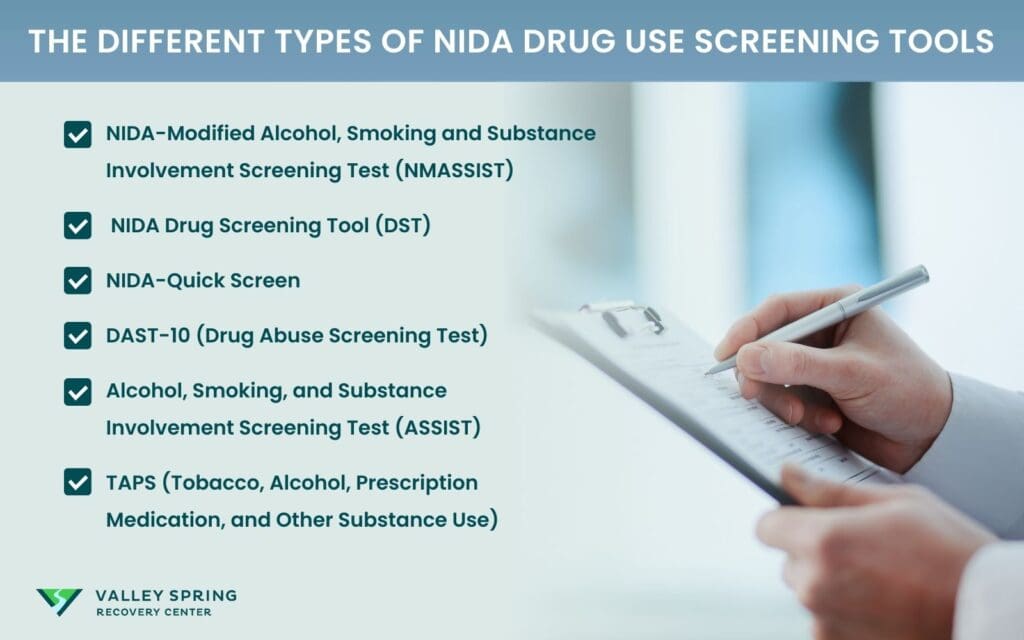
The National Institute on Drug Abuse (NIDA) has developed and supported the development of various drug use screening tools. Here are a few examples of commonly used NIDA screening tools:
1. NIDA-Modified Alcohol, Smoking and Substance Involvement Screening Test (NMASSIST)
This tool is designed to screen for substance use disorders, including alcohol, tobacco, and other drugs. It consists of a series of questions that assess the individual’s substance use patterns, consequences, and readiness to change.
2. NIDA Drug Screening Tool (DST)
The NIDA DST is a brief questionnaire that screens for drug use and identifies potential problems associated with drug use. It asks about the types of drugs used, frequency of use, consequences experienced, and treatment history.
3. NIDA-Quick Screen
The NIDA-Quick Screen is a brief, self-administered tool that screens for drug use in general medical settings. It consists of three questions that ask about past-year drug use, prescription drug misuse, and drug-related difficulties.
4. DAST-10 (Drug Abuse Screening Test)
The DAST-10 assesses an individual’s drug use and the potential problems associated with drug abuse. It consists of 10 yes/no questions that cover various aspects of drug use, such as consequences, dependence symptoms, and loss of control.
5. Alcohol, Smoking, and Substance Involvement Screening Test (ASSIST)
While not developed directly by NIDA, the ASSIST is an internationally recognized screening tool for substance use. It assesses an individual’s use of alcohol, tobacco, and other drugs, as well as the associated problems and risks.
Research by Humeniuk, et al (2010), titled The Alcohol, Smoking and Substance Involvement Screening Test (ASSIST): manual for use in primary care. Geneva, World Health Organization, showed that the implementation of the ASSIST in primary care has shown that it is an effective tool for identifying patients with substance use issues. It has been validated in various studies and is recommended for use by healthcare providers to help reduce the burden of substance-related harm worldwide
6. TAPS (Tobacco, Alcohol, Prescription Medication, and Other Substance Use)
The TAPS, is a comprehensive screening tool that assesses an individual’s substance use across multiple categories, including tobacco, alcohol, prescription medications, and other drugs. Research by McNeely J, et al, titled Performance of the Tobacco, Alcohol, Prescription Medication, and Other Substance Use (TAPS) Tool for Substance Use Screening in Primary Care Patients. (2016) pointed out that the TAPS screening tool is designed to provide a broad assessment of substance use patterns and related problems.
These are just a few examples of the drug use screening tools supported by NIDA. It’s important to note that different tools may be used in different settings or for specific populations, and the specific questions and formats may vary.
Is the NIDA Drug Use Screening Tool confidential?
Yes, the NIDA Drug Use Screening Tool is typically administered with confidentiality in mind. Confidentiality is crucial to create a safe and non-judgmental environment that encourages individuals to provide honest and accurate information about their drug use. Healthcare professionals and researchers are responsible for ensuring the privacy of the individual’s responses, protecting their personal information, and using the collected data solely for the intended purposes of assessment and intervention.
Does a positive screening result mean someone has a drug problem?
No, a positive screening result on the NIDA Drug Use Screening Tool does not necessarily indicate that someone has a drug problem. A positive result suggests the need for further assessment to gather more detailed information about an individual’s drug use patterns and related issues. It serves as an indicator that there may be a higher risk or potential for drug-related problems.
Absolutely, here are some additional FAQs on the NIDA Drug Use Screening Tool:
What types of drugs does the screening tool cover?
The NIDA tool screens for the use of a wide range of drug types, including:
- Illegal drugs (e.g. marijuana, cocaine, heroin, methamphetamine)
- Prescription medications used in a non-medical way (e.g. opioid painkillers, sedatives, stimulants)
- Over-the-counter medications used excessively
It does not cover the use of alcohol or tobacco, as those are typically assessed separately.
What resources are available to support use of the screening tool?
NIDA provides free training materials and implementation guides to help healthcare organizations successfully integrate the screening tool into their clinical workflows. There are also online tools and calculators available to score the screening results.
Additionally, NIDA has developed accompanying brief intervention and referral to treatment resources to assist providers in addressing positive screening results.
How is the NIDA screening tool different from SBIRT?
The NIDA Drug Use Screening Tool is a specific instrument used to identify individuals at risk for drug use problems, while SBIRT is a broader framework that includes screening, brief intervention, and referral to treatment.
The NIDA tool provides a standardized risk assessment score, while SBIRT involves a more tailored, motivational interviewing-based approach for the brief intervention and treatment connection.
Both are complementary, evidence-based approaches, with the NIDA tool serving as the initial screening step within the comprehensive SBIRT model for early intervention and treatment of substance use disorders.
How does the NIDA Drug Use Screening Tool complement the SBIRT approach in addiction treatment?
The NIDA Drug Use Screening Tool complements the SBIRT approach by providing a standardized method for identifying individuals at risk of substance use disorders. The NIDA tool offers a comprehensive assessment of drug use patterns and potential problems, which can inform the brief intervention component of SBIRT. This integration allows healthcare providers to tailor interventions more effectively and provide appropriate referrals to treatment based on the severity of the individual’s substance use. Using both tools together enhances the overall efficacy of early identification and intervention strategies in addiction treatment.
How is the NIDA Drug Use Screening Tool different from the CRAFFT Screening Test, and what are their specific applications?
The NIDA Drug Use Screening Tool and the CRAFFT Screening Test serve similar purposes but are designed for different populations and settings. The NIDA tool is a comprehensive screening instrument suitable for adults and can be used in various healthcare settings to assess a wide range of substance use behaviors. In contrast, the CRAFFT Screening Test is specifically designed for adolescents and focuses on identifying high-risk alcohol and drug use behaviors in this age group. The NIDA tool includes detailed questions about the frequency and impact of substance use, while the CRAFFT test uses a brief, structured questionnaire to quickly identify potential substance use problems. Understanding the differences and specific applications of these tools helps clinicians choose the most appropriate screening method for their patient population.
What are the advantages of using the NIDA Drug Use Screening Tool in primary care settings?
The advantages of using the NIDA Drug Use Screening Tool in primary care settings include its ability to provide a quick and comprehensive assessment of a patient’s substance use, which is crucial for early detection and intervention. The tool is designed to be user-friendly and can be easily integrated into routine primary care visits, allowing healthcare providers to identify at-risk individuals and address substance use issues promptly. Additionally, the NIDA tool facilitates open communication between patients and providers about substance use, reducing stigma and encouraging patients to seek help. By incorporating this screening tool into primary care, providers can improve patient outcomes through early intervention and referral to appropriate treatment services.
Dr. Michael Olla
All author postsShare This Post

